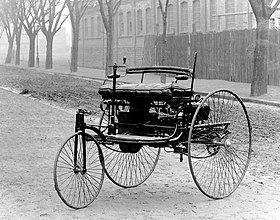
Back Benz Patent-Motorwagen AN بنز باتينت موتورفاغن Arabic Benz Patent-Motorwagen Azerbaijani Benz Patent Motorwagen BCL Benz Patent-Motorwagen Nummer 1 Byelorussian Бенц Патент Моторваген Bulgarian Benz Patent Motorwagen číslo 1 Czech Benz Patent-Motorwagen Nummer 1 German Benz Patent-Motorwagen Esperanto Benz Patent-Motorwagen Spanish
| Benz Patent-Motorwagen | |
|---|---|
 Benz Patent-Motorwagen Nr. 1 | |
| Overview | |
| Manufacturer | Rheinische Gasmotorenfabrik Benz & Cie. (known today as Mercedes-Benz) |
| Production | 1886–1893 |
| Body and chassis | |
| Layout | Rear Engine, RWD |
| Powertrain | |
| Engine | 1.0 L (954 cc) single cylinder engine (Ligroin fuel) |
| Power output | 2⁄3 brake horsepower (0.68 PS; 0.50 kW) @ 400 rpm 4⁄5 newton-metre (0.59 lb⋅ft) |
| Transmission | Single-Speed Belt Drive |
| Dimensions | |
| Wheelbase | 57.1 inches (1,450 mm) |
| Length | 106.3 inches (2,700 mm) |
| Width | 55.1 inches (1,400 mm) |
| Height | 57.1 inches (1,450 mm) |
| Curb weight | 600 pounds (270 kg) |
| Chronology | |
| Successor | Benz Velo |
The Benz Patent-Motorwagen ("patent motorcar"), built in 1885 by the German engineer Karl Benz, is widely regarded as the first practical modern automobile[1][a] and was the first car put into production.[8] It was patented in January 1886 and unveiled in public later that year. The original cost of the vehicle was 600 imperial German marks,[9] approximately 150 US dollars (equivalent to $5,200 in 2024).
Two years after Karl Benz drove the car in public in July 1886,[10] Karl's wife Bertha demonstrated its feasibility in a trip from Mannheim to Pforzheim in August 1888. Around the same time, the Patent-Motorwagen became the first commercially available automobile in history.[11] Émile Roger, who made Benz engines under license in France, was one of the first persons to buy Benz' car; from 1888, Roger was also the salesperson of the Benz Patent-Motorwagen in France, selling one to Émile Levassor in 1888.[12][13] The Patent-Motorwagen was shown at an exhibition in Munich in 1888, winning a gold medal, and at the 1889 Paris Exposition.[13]
Due to the creation of the Patent-Motorwagen, Karl Benz has been hailed as the father and inventor of the automobile.[1][14][15]
- ^ a b c Parissien, Steven (2014). The life of the automobile : the complete history of the motor car. Internet Archive. New York, N.Y. : Thomas Dunne Books, St. Martin's Press. pp. 2–5. ISBN 978-1-250-04063-3.
- ^ "Nicolas-Joseph Cugnot". Encyclopædia Britannica. Retrieved 22 October 2022.
- ^ Lavergne, Gérard (1902). The Automobile: Its Construction and Management. Cassell. p. 17.
- ^ Frey, Carl Benedikt (2020). The Technology Trap: Capital, Labor, and Power in the Age of Automation. Princeton University Press. p. 166. ISBN 9780691210797.
- ^ Bailey, Diane (2015). How the Automobile Changed History. ABDO. p. 28. ISBN 9781629697666.
- ^ Georgano, G. N. (1985). Cars, 1886–1930. Beekman House. pp. 9, 16. ISBN 9780517480731.
- ^ "Forerunners to the automobile". Mercedes-Benz Group. Retrieved 22 October 2022.
- ^ "Der Streit um den "Geburtstag" des modernen Automobils" [The fight over the birth of the modern automobile] (in German). German Patent and Trade Mark Office. 2014-12-22. Archived from the original on 2017-01-02.
- ^ Neil, Dan (2006-06-21). "Before the Rumble Seat". Los Angeles Times. Retrieved 2020-05-02.
- ^ Karl Benz drives the first automobile 3 July 1886 edn.com
- ^ "Carl Benz and the Invention of the Automobile". 29 January 2018.
- ^ Hendrickson, Kenneth E. (2014). The Encyclopedia of the Industrial Revolution in World History. Vol. 3rd. Rowman & Littlefield Publishers. p. 88. ISBN 9780810888883.
- ^ a b Rauck, Max (1986). "Das 1. Auto ist 100" [The first car is 100 years old]. Kultur & Technik (in German). Deutsches Museum. p. 70.
- ^ von Fersen, Olaf (2013). Ein Jahrhundert Automobiltechnik: Personenwagen (in German). Springer-Verlag. p. 10. ISBN 9783642957727.
- ^ Derry, Thomas Kingston; Williams, Trevor Illtyd (1960). A Short History of Technology from the Earliest Times to A.D. 1900. Courier Corporation. p. 393. ISBN 9780486274720.
Cite error: There are <ref group=lower-alpha> tags or {{efn}} templates on this page, but the references will not show without a {{reflist|group=lower-alpha}} template or {{notelist}} template (see the help page).